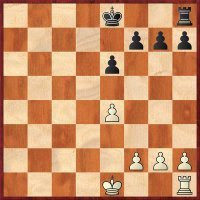Here it si another Kosteniuk's great game.
The knight in d3 is scary! Put pieces in advanced squares it´s half of the way to control the entire board.
Archive
-
▼
2009
(21)
-
►
02
(13)
- Restart
- Chess Rules X - The annotation
- Chess Rules X - The value of the pieces, the impor...
- Chess Rules IX - Exceptions in the movement of the...
- Chess Rules VIII - The King (check, checkmate and ...
- Chess Rules VII - The King
- Chess Rules VI - The Knight
- Chess Rules V - The Queen
- Chess Rules IV - The Rooks
- Chess Rules III - The Bishops
- Chess Rules II - The Pawns
- Chess Rules I - The Board/The Pieces
- Welcome!
-
►
02
(13)
Categories
- Anand (1)
- Balashov (1)
- Blitz (4)
- Castle (1)
- Check (1)
- Checkmate (1)
- Chess Pieces (1)
- Chess Rules (10)
- Chess Strategy (1)
- Chess video (1)
- Chess videos (2)
- Chessboard (1)
- Exceptions in the movement of the pieces (1)
- Fair play (1)
- Geri's Game (1)
- Jackova (1)
- Kasparov (1)
- king (1)
- Korchnoi (1)
- Kosteniuk (4)
- Krapivin (1)
- Military Strategy (1)
- Pixar (1)
- Play chess (8)
- restart (1)
- Short Film (1)
- Sofia Polgar (1)
- Stalemate (1)
- Sun Tzu (1)
- the annotation (1)
- The art of war (1)
- The Bishops (1)
- the importance of the centre (1)
- The King (1)
- The Knight (1)
- The Pawns (1)
- The Queen (1)
- The Rooks (1)
- The value of the pieces (1)
- Welcome (1)
- Zhu Chen (1)
Links
11/29/09
Blitz Jackova - Kosteniuk
Posted by:
Mr. Crowley
em
6:31 AM
0
comments
![]()
11/28/09
Geri's Game - Pixar's Short Film
Now here's a short video released by Pixar in 1997, and winer of the best animation film prize in that year, has also won several awards for best animated feature and best short film in the following year.
Hope you enjoy it.
Posted by:
Mr. Crowley
em
10:18 AM
0
comments
![]()
Labels: Geri's Game, Pixar, Short Film
11/27/09
Blitz Kosteniuk - Zhu Chen
Enjoy the wisdom of Alexandra Kosteniuk...
Posted by:
Mr. Crowley
em
6:28 PM
0
comments
![]()
11/23/09
Military Strategy vs. Chess Strategy
 Sun Tzu lived in the fourth century BC, and was a respected General in China that NEVER lost a battle.
Sun Tzu lived in the fourth century BC, and was a respected General in China that NEVER lost a battle.The memory of this great military strategist is still alive to this day due to his work: "The art of war". This book is the most popular strategy work of the current days, being studied around the world for entrepreneurs, in order to prepare for the business world.
His teachings are also useful for Chess due to the depth and breadth of his ideas.
Here are some Sun Tzu's ideas (commented) that everyone should know:
"a military commander must attack where the enemy is unprepared and must use paths that, for the enemy, are unexpected ..." - Principle of Surprise;
"If you discover the weakness of the opponent, you must affect it quickly. Capture, initially, what is very valuable to the enemy. Do not reveal the time of the attack." - Principle of vulnerabilities;
"Invincibility is in defense, the possibility of victory in the attack. Who defends shows that his strength is inadequate; who attacks, shows that it is abundant." (In Chess is important to defend when we are in the lower position and attack when we are in advantage, attack in lower position is suicide);
"If it isn't advantageous, never send troops; if it yields no profit, never use your men; if it isn't a dangerous situation, never fight a battle hasty ..." (Attacks must be planned, there should be harmony between the parts, attack without activate all the parts is precipitated);
"If you know the enemy and yourself, you needn't fear the result of a hundred battles. If you know yourself but not the enemy, for every victory gained you will also suffer a defeat. If you don't know neither the enemy nor yourself, you will lose all the battles. " (Knowing our strengths and weaknesses is extremely important in chess, in order to choose the best ways to trick our opponent);
"Keep them under stress and tire them." (All moves should improve our position, the pressure must be constant);
"He who is prudent and wait for a reckless enemy will be victorious."
Posted by:
Mr. Crowley
em
2:06 AM
0
comments
![]()
Labels: Chess Strategy, Military Strategy, Sun Tzu, The art of war
11/22/09
Blitz Kosteniuk-Balashov
A quick match, commented by the current World Chess Champion, more will come ...
Posted by:
Mr. Crowley
em
3:09 AM
0
comments
![]()
Labels: Balashov, Blitz, Chess videos, Kosteniuk
11/21/09
The Great Players Also Err ...
In today's video we present a snippet of a game between two giants of the world of chess, Kasparov and Anand, where you can clearly see the surprise reaction of Kasparov after his opponent's move, revealing all of their emotions.
Posted by:
Mr. Crowley
em
11:25 AM
0
comments
![]()
Labels: Anand, Chess videos, Kasparov
3/3/09
Fair play in chess
Posted by:
Mr. Crowley
em
3:57 AM
0
comments
![]()
Labels: Chess video, Fair play, Korchnoi, Sofia Polgar
2/28/09
Restart
Posted by:
Mr. Crowley
em
10:12 AM
0
comments
![]()
Labels: Play chess, restart
2/27/09
Chess Rules X - The annotation

To write down a play, each player registers his move and the adversary's move.
- Normal move:
1st - It Is Written down by capital letter, the initial of the Piece that was moved;
2nd - Next, with small letter, the square for where the piece moved.
Important: The square is identified writing first, with small letter, the corresponding Column of the square, following the corresponding number of the Line that belongs to target square of the piece.
- Capture's move:
1st - There Is Written down the initial of the Piece that moved;
2nd - following it's Written down an "X", that is the sign of capture;
3rd - finally, it's written down the square of the Captured Piece.
Obs.: 1-It's not necessary to write down the name of the captured piece, just identify correcly the square where the captured piece was.
2-when the piece is a Pawn, it is not necessary to write the initial of the Piece. So, whenever a move is written down without the initial capital letter, it is already known that is a Pawn's move.
- Promotion's move:
It is written down normally the movement of the Pawn up to the final rank. After the written down move, there is registered a sign of equality (=) and the initial capital letter of the new piece that is promoted. Ex.: c8=Q or cxd8=R. In the first case, the Pawn who was in c7 advanced for c8 and promoted a Queen; in the second case, the Pawn who was in c7, captured a piece (Knight e.g.) in d8 and the Rook was promoted. In both cases, the player is free to chose what piece is promoted.
Example:
White, Black
1- e4, e5
2 - Nf3, Nc6
Conventional signs: There are several signs used during the play or in annotations of the play, with the objective to point out determined specific aspect of the move. Let's see the most used ones:
.
Captures x
Check +
Checkmate ++
Good move !
Very good move !!
Bad move ?
Very bad move ??
Castle King Side 0-0
Castle Queen Side 0-0-0
' en passant ' e.p.
Proposal of Draw (=)
.
Attention: It is very common among beginners not wanting to write down the plays because of thinking that it loses the concentration (generally, in tournaments among not federated).
.
NEVER THIS MISTAKE IS ALLOWED!
.
The accomodation of this task, it obstructs the player of later to analyse the play and to correct the committed mistakes. Then, if his wish is to become a good player, it follows the example of the best.
.
WRITE DOWN YOUR PLAY!
.
It still can happen, that the habit of writing down the moves favors the development of the concentration. So that, the annotation of the play, it must always be stimulated.
Posted by:
Mr. Crowley
em
10:12 AM
0
comments
![]()
Labels: Chess Rules, the annotation
2/26/09
Chess Rules X - The value of the pieces, the importance of the centre
The value of the pieces
Has come the time of talking about the value of each piece:
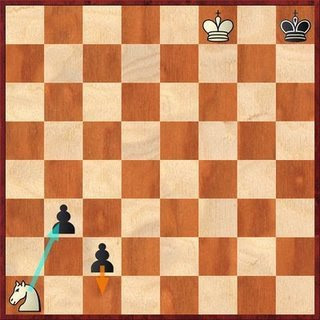 In this position the white Knight is at one of the extremities of the board and can move only for 2 squares where there are the black Pawns
In this position the white Knight is at one of the extremities of the board and can move only for 2 squares where there are the black Pawns

Posted by:
Mr. Crowley
em
1:01 PM
0
comments
![]()
Labels: Chess Rules, the importance of the centre, The value of the pieces
2/22/09
Chess Rules IX - Exceptions in the movement of the pieces - Castle
Castling is the only movement where it is possible to move two pieces in the same move, the King and the Rook. this move allows to place the King more near to one of the corners of the board, where it will be more protected.
- The King and the Rook must be at his initial position;
- None of the two can already have moved;
- There cannot be pieces between both;
- The King cannot be in Check, pass or be at a square that is being attacked;
Castling King side:
Castling Queen side:
Cases in which it is not possible to Castle:

The white King is in Check

white King cannot Castle since it would be going to be placed at a square that is being attacked by the adversary's

Both Kings moved already, because they cannot Castle
Posted by:
Mr. Crowley
em
11:01 AM
0
comments
![]()
Labels: Castle, Chess Rules, Exceptions in the movement of the pieces
2/21/09
Chess Rules VIII - The King (check, checkmate and stalemate)
- To capture the attacking piece;
- To put one of your pieces between the attacking piece and your King (unless the offensive piece is a Knight);
- To move the King for a square where it is not being attacked.
If the player who's in check is not able to carry out any of the operations above mentioned, he is in checkmate and the play finished.
Both Kings have to maintain at least 1 square of distance between them, in order to not place themselves in check.
If a player is not in check, but it will not be able to do any legal move (not even with the King or the remaining pieces ), the position is of "stalemate" and the play is a drawn.
Examples of Checkmate:

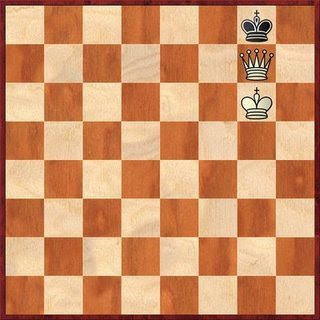

Examples of check:

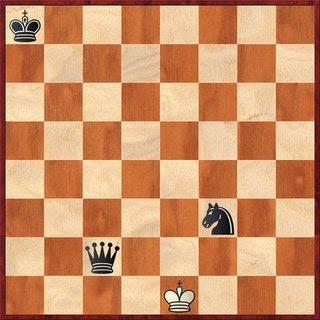
Example of stalemate:

In this position is the White to play and they have not any legal move to do.
Posted by:
Mr. Crowley
em
2:58 AM
0
comments
![]()
Labels: Check, Checkmate, Play chess, Stalemate, The King
2/19/09
Chess Rules VII - The King

O Rei pode mover 1 quadrado de todas as direções, and it can capture the adversary's pieces that are in these squares, only if these are not protected by other pieces (such as it is exemplified in the next image).
 The King can never be captured! The objective of the play consists in imprisoning the King, in other words, attack it in way that it can not escape, what will be explained in the next post.
The King can never be captured! The objective of the play consists in imprisoning the King, in other words, attack it in way that it can not escape, what will be explained in the next post.
Posted by:
Mr. Crowley
em
1:15 PM
0
comments
![]()
Labels: Chess Rules, king
2/18/09
Chess Rules VI - The Knight

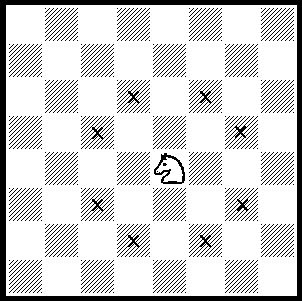
Posted by:
Mr. Crowley
em
2:49 AM
0
comments
![]()
Labels: Chess Rules, Play chess, The Knight
2/17/09
Chess Rules V - The Queen
The Queen is a mighty piece, whose movement is easy of being learnt, she moves by the diagonals (such as the bishop), and for the lines and columns (such as the tower), being the mightiest piece of the board and being placed in the initial position beside the King (white Queen at white square, black Queen at black square).

Capture - The Queen can capture such as the Bishop or the Rook, being able to capture any adversary's piece that stands in his way, occupying the place of the captured piece.
Hint - By being the mightiest piece, the initiates in this art usually move it frequently, however such it is not advised, since due to his power it can be attacked by adversary's pieces weaker than it, what will oblige it moving back. The development of the Queen must be quite prudent.
Posted by:
Mr. Crowley
em
3:52 AM
0
comments
![]()
Labels: Chess Rules, Play chess, The Queen
2/16/09
Chess Rules IV - The Rooks

Movement - The Rook moves in straight lines, in other words, along the lines and columns, as it is demonstrated in the next image:

The Rook can only move along the lines and/or columns if they are unoccupied, if not, his mobility is compromised. As we can see in the next image the Rook is enclosed by pieces of his color, seeing so his mobility come down only to 5 squares instead of 14 when the lines and columns are unoccupied.

Capture - The Rook, such as the Bishop already previously explained, can capture the adversary's pieces which stands in his way.

As we can see in the image above presented, the Rook can capture the adversary's Bishop.
Hint - The Rook has tactic functions of dominating open columns (without Pawns) where his movements can be well used, not being therefore much played in the initial phase of the play,but yes in the middlegame and endgame.
Posted by:
Mr. Crowley
em
6:50 AM
0
comments
![]()
Labels: Chess Rules, Play chess, The Rooks
2/14/09
Chess Rules III - The Bishops

Movement - The Bishops can only move in diagonals, as it's shown in the next image:

Capture - The Bishop can capture the adversary's pieces which are placed in his way.

As we ca see in the previous image the Bishop can move along his two diagonals, beeing able, in thi case, of capturing the adversary's Queen.
.
Hint - The pair of Bishops is a very powerful weapon, being, in most cases, considered superior to the pair of Knights. The bishop reaches his whole splendor in positions where there are no pieces or pawns to limit his movements.
Posted by:
Mr. Crowley
em
5:08 AM
0
comments
![]()
Labels: Chess Rules, Play chess, The Bishops
2/10/09
Chess Rules II - The Pawns
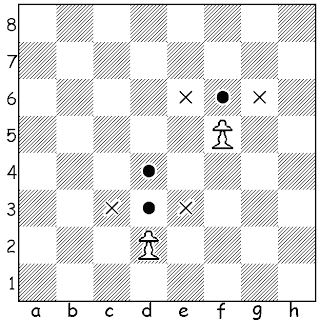

Step 2 - Black plays his side pawn 2 squares, and they are side by side.


Hint - Normally, the beginner has an exaggerated tendency in moving all or almost all the Pawns in the first moves of the game, this must be avoided because the Pawns are weak and once played cannot be moved backwards, so it is more prudent to advance only the central Pawns and develop the rest of the pieces, in order to control the centre of the board, and this way, control the play.
Posted by:
Mr. Crowley
em
12:58 AM
0
comments
![]()
Labels: Chess Rules, Play chess, The Pawns
2/7/09
Chess Rules I - The Board/The Pieces
The initial position of the pieces in the chess board is the one represented in the image above. The chess board consists of 64 squares arranged by 8 columns and 8 lines, 32 white squares and 32 black squares.
Each player, in the beginning of the game, has 8 Pawns, 2 Knights, 2 Bishops, 2 Rooks, 1 Queen and 1 King (in the next posts will be explained the movements of these pieces).
The objective of this game is to give Checkmate to the adversary's King (imprison the adversary's King, this subject will be explained in the "King's movement" post).
From now I must alert you for the importance of the central squares, being chess a game that represents 2 armies in combat, the center of the board it has an extreme importance in this battle, since it's here where most of the pieces can manoeuvre more easily for any extreme of the board.
Posted by:
Mr. Crowley
em
10:30 AM
0
comments
![]()
Labels: Chess Pieces, Chess Rules, Chessboard, Play chess
Welcome!
Here you will find everything what you always wanted to know about this fabulous art!
If you have any doubt, please contacts us, we are here to help you.
Join in this journey and improve your knowledge about this game!
Posted by:
Mr. Crowley
em
4:02 AM
0
comments
![]()
Labels: Welcome
